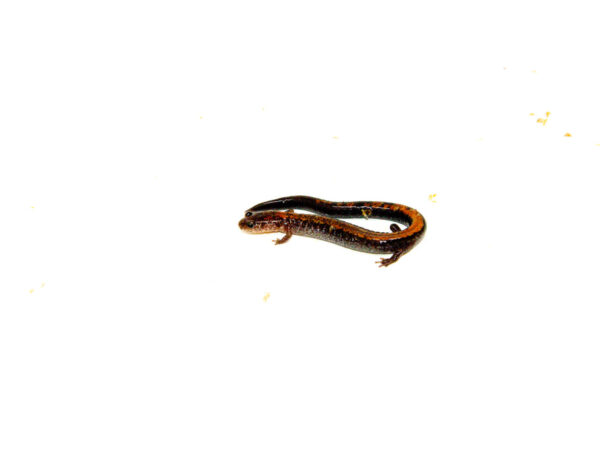Southern Slimy Salamander (Plethodon teyahalee): A Secretive Jewel of the Forest Floor
The southern slimy salamander (plethodon teyahalee) is a striking member of the Plethodontidae family, native to the Appalachian Mountains and southeastern United States. True to its name, this elusive amphibian is known for the thick, sticky mucus it secretes as a defense mechanism—making it a fascinating subject for herpetology enthusiasts and nature lovers alike.
At OneStopReptileShop.com, you’ll find a wide range of essential supplies and habitat accessories tailored for species like the southern slimy salamander, from bioactive substrate blends to live moss and secure terrarium hides.
Appearance and Identification
The southern slimy salamander (plethodon teyahalee) is easily recognized by its unique coloring and slightly stocky build. It typically has a black body adorned with white or silver speckling that extends along the flanks, head, and tail. These speckles give the salamander a starry-night appearance that glimmers under the right lighting.
Key Physical Traits:
-
Size: 4.5–6.5 inches in total length
-
Color: Jet black base with varying white to silver speckling
-
Skin: Smooth, moist, and capable of producing a sticky mucus
-
Limbs: Short but strong, adapted for crawling in crevices and under debris
The “slimy” nickname refers to its ability to produce copious mucous secretions when disturbed, which deters predators and makes handling tricky.
Habitat and Distribution
Plethodon teyahalee is primarily found in moist deciduous forests across the southern Appalachian Mountains, ranging through:
-
North Georgia
-
Western North Carolina
-
Eastern Tennessee
-
Northern Alabama
It prefers cool, moist microhabitats under rocks, rotting logs, and dense leaf litter. These salamanders are entirely terrestrial and do not require standing water for breeding, unlike many other amphibians.
Behavior and Ecology
Southern slimy salamanders are nocturnal and secretive, usually coming out at night or after rain to forage. They are:
-
Solitary and territorial
-
Opportunistic insectivores
-
Quick to retreat when disturbed
-
Capable of regenerating lost tails
They are also lungless, breathing entirely through their skin and the lining of their mouths, which is why maintaining high humidity is critical in captivity.
Captive Care Requirements
While not as commonly kept as aquatic salamanders, the southern slimy salamander (plethodon teyahalee) can thrive in a well-maintained naturalistic setup.
Terrarium Recommendations:
-
Enclosure Size: 10–20 gallons per adult
-
Temperature: 60–70°F (cooler environments preferred)
-
Humidity: 75%–95%
-
Substrate: Moist coco fiber, sphagnum moss, and organic soil mix
-
Décor: Bark pieces, cork rounds, leaf litter, and flat stones
Consider using live moss and springtails to create a bioactive vivarium, which not only replicates their natural environment but also simplifies maintenance. All necessary supplies are available at OneStopReptileShop.com.
Diet and Feeding
Southern slimy salamanders are voracious feeders, consuming a range of invertebrates. Offer them:
-
Flightless fruit flies
-
Small crickets
-
Springtails
-
Isopods
-
Waxworm larvae (occasionally)
Feed juveniles daily and adults 2–3 times per week. Food items should be appropriately sized and dusted with calcium supplements every other feeding.
Breeding and Reproduction
One of the unique traits of southern slimy salamander (plethodon teyahalee) is its terrestrial reproduction. Females lay eggs in moist crevices, guarding them until they hatch. Unlike many amphibians, the offspring bypass the larval aquatic stage and hatch directly into miniature versions of the adults.
Breeding in captivity is rare but possible with environmental cycling and undisturbed nesting areas.
Handling and Temperament
Due to their delicate, absorbent skin and sticky defensive secretions, these salamanders are best admired without handling. If it becomes necessary:
-
Wet hands with dechlorinated water
-
Handle gently and briefly
-
Avoid lotions, oils, and soap before contact
They thrive best in observation-focused enclosures, offering hours of rewarding natural behavior.
Why Choose the southern slimy salamander (plethodon teyahalee)?
This species is a low-maintenance yet exotic amphibian that can be kept in cooler indoor environments. With their beautiful speckled appearance and interesting defensive adaptations, southern slimy salamander (plethodon teyahalee) are ideal for:
-
Bioactive vivarium enthusiasts
-
Amphibian collectors seeking rarer species
-
Education-focused terrarium displays
Whether you’re just getting started or you’re an experienced keeper, you can shop all necessary gear—misting systems, substrates, décor, and microfauna—at OneStopReptileShop.com.









Reviews
There are no reviews yet.